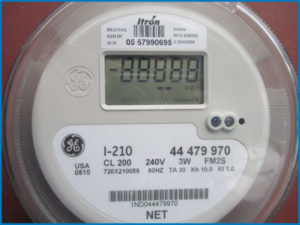When your California home or business sends energy to the grid the meter rolls backward and you receive bill credits!
Solar Net Energy Metering (NEM) is one of the primary financial incentives utilities offer their customers to go solar. Net Energy Metering is a solar incentive that allows the homeowner or business owner to store energy in the utility’s electric grid. When your solar panels produce more electricity than you need, that energy is sent to the grid in exchange for bill credits. Then, at night or other times when your solar panels are underproducing (Winter months or cloudy/rainy days), you pull energy from the grid and use these bill credits to offset the costs of that energy. One of the most common questions I receive from homeowners and businesses is “Can I sell my solar energy back to the grid”? The answer depends on your local utility. In California, all electric utilities are only offering bill credits, not cash, for excess solar energy production sent back to the grid.
When your California home or business sends energy to the grid the meter rolls backwards and you receive bill credits!
Solar energy systems typically generate peak electricity production in the afternoon when many people aren’t home using electricity. By contrast, home electricity use is typically higher in the morning and evening. Net Energy Metering helps you to account for these variations in your day-to-day electricity production and usage.
With Net Energy Metering, excess electricity is fed into your electric utility’s grid when your system is producing more energy than you need. When this happens, your meter runs in reverse. When your system isn’t producing enough electricity, you draw the energy needed from your utility just as you did before you went solar. With Net Energy Metering, the excess electricity your home or business produces cover the times when your solar system doesn’t produce enough energy.
When your solar system generates more electricity than you use over the course of a month, your utility will issue a bill credit based on the net number of kilowatt hours you sent to the grid. If you produce less electricity than you use in each month, you must buy electricity from your utility to make up the difference. In these instances, you would pay for the electricity you use, minus any excess electricity your solar panels generated. At the end of the year the utility will issue an annual “true up” bill for any consumption above and beyond what your solar system generated that year.
Most large businesses that install solar systems on their roofs (onsite) consume more energy than the solar system produces and are net importers of energy from the electric utility grid. However, many smaller businesses can benefit from Net Energy Metering like a homeowner by exporting more energy than the business consumes. In either scenario, businesses can rest assured all the electricity they produce from their on-site solar system is being consumed or used to offset future consumption.
Interested in hiring Beach Cities Solar Consulting LLC to provide a turnkey home or business solar and energy storage proposal? Get started by e-mailing us a copy of your most recent electric bill (12 months for businesses), a picture of your home’s electrical panel (or switchgear for businesses), and a picture of your roof material today: info@beachcitiessolarconsulting.com.


